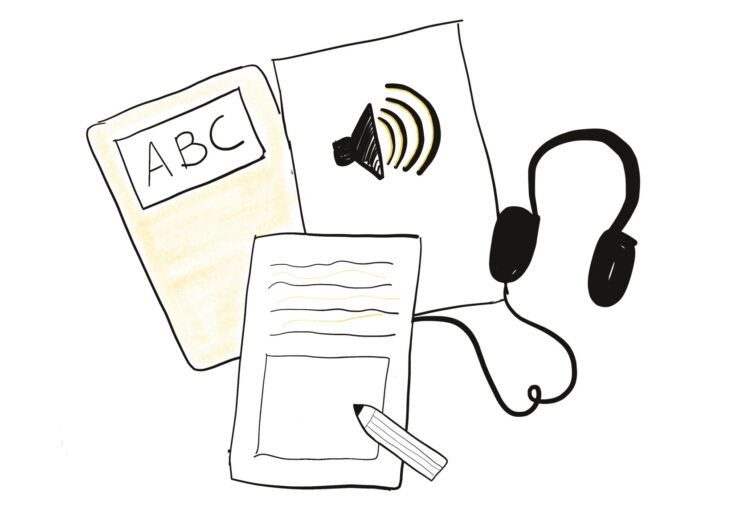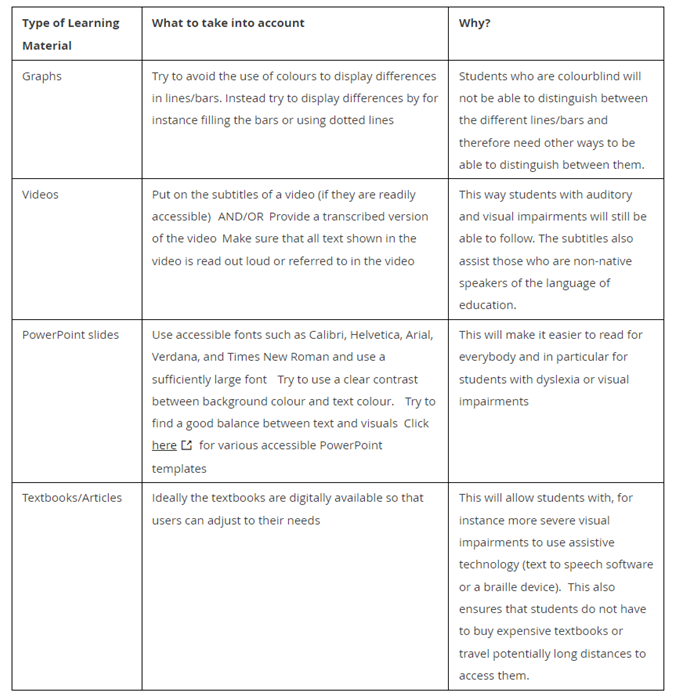Accessibility of learning materials

“As a student with a visual disability, I have had many difficulties with accessing visual material in larger lecture halls, because I can only see things when they are very close to me. This means that lectures need to provide the material before class starts so that I can see them up close on my own laptop or from print. I fully understand that lecturers want to make last-minute changes, but every time when I did get materials in time, I noticed how much more easy it is for me to understand the content of the lecture by hearing and seeing the information at the same time, as everyone does“
“During COVID, with all the online meetings, it was anyway far easier for me to take in visual information. During online meetings, it’s possible to pause or go back to slides if I couldn’t process visual information quickly enough. And often times, when we meet in hybrid form and I’m physically present and unable to read a screen that’s far away, I would sign in online anyway, and view slides on my own computer screen as people view them when they are following the meeting from home”
There may be several reasons why students may experience difficulties in accessing learning material. One reason may be because they have a mental or physical disability. According to the Dutch Expert centre on inclusive education (2020), out of all students in Dutch education, 30% have special needs ECIO (2020). Teacher‘s guide with tips: How to contribute to inclusive and accessible education. . 10% of students experience difficulties with studying due to a disability, which could be e.g., auditory impairments, students with ADHD or dyscalculia. They may, for instance, have problems with processing visual information such as tables and figures, may have difficulty with reading long texts, or hearing sound in video materials.
Students may also encounter learning barriers if they have low socioeconomical status. For example, they may not have access to all the digital equipment necessary to follow a course taught (partially) online. Another example of a group who may experience difficulties in accessing learning materials are students who are e.g., non-native speakers of Dutch following a Dutch course. They may also need more time to comprehend the content of learning material or understanding the socio-cultural context of a case or text.
To address these barriers, it is necessary to try to make the learning materials as accessible as possible. However, as there are many aspects of diversity which may lead to difficulty in accessing learning material, there is no one size fits all solution. Therefore, taking everything into account at once can be challenging. In this section, we provide some general recommendations, but also advise you to involve your students by asking them what you can do to ensure the learning materials are accessible.
Tools
General Recommendations
Please find some general recommendations on making your learning material accessible
Bain, K., Basson, S., Faisman, A., & Kanevsky, D. (2005). Accessibility, transcription, and access everywhere. IBM systems journal, 44(3), 589-603. 10.1147/sj.443.0589
Fichten, C. S., Asuncion, J. V., Barile, M., Ferraro, V., & Wolforth, J. (2009). Accessibility of e-learning and computer and information technologies for students with visual impairments in postsecondary education. Journal of visual impairment & blindness, 103(9), 543-557
Raskind, M., Hoffman, B., Hartley, K., & Boone, R. (2005). Reaching accessibility: Guidelines for creating and refining digital learning materials. Intervention in School and Clinic, 40(3), 171-176.
.
- Make sure that you explain all key terms and symbols used in your course in simpler words, more commonly used expressions or visuals display. You can also recommend background material so that students can access additional information where necessary.
- Highlight which information is most relevant, what the structure is, and how various sources of information are interrelated.
- Offer information in different media. In academia, information is usually presented in written form, but you may also consider knowledge clips, images, models, videos, or podcasts.
- Offer ways of customizing the display of information so that various perceptual features can be altered. This can be done by offering information in digital format so that students can alter font-size; contrast between text and image; volume or rate of speech or sound. Students with visual disabilities may also use technology that enables written text to be read out aloud. Students working in a second (or third) language may slow down videos to better follow the language.
In the table below are some concrete examples of how to adjust different types of learning material.

Based on
Bain, K., Basson, S., Faisman, A., & Kanevsky, D. (2005). Accessibility, transcription, and access everywhere. IBM systems journal, 44(3), 589-603. 10.1147/sj.443.0589
Fichten, C. S., Asuncion, J. V., Barile, M., Ferraro, V., & Wolforth, J. (2009). Accessibility of e-learning and computer and information technologies for students with visual impairments in postsecondary education. Journal of visual impairment & blindness, 103(9), 543-557.
Raskind, M., Hoffman, B., Hartley, K., & Boone, R. (2005). Reaching accessibility: Guidelines for creating and refining digital learning materials. Intervention in School and Clinic, 40(3), 171-176.
Additional Resources
The list of general guidelines is an adaptation of the ‘Representation’ section of the UDL Guidelines. For more extensive information, go to https://udlguidelines.cast.org/representation/perception/customize-display
Expert centre on inclusive education. This centre develops innovative and practical solutions for more inclusive education. Particular focus on students with special needs and disabilities www.ecio.nl/en
Accessibility of online environments: https://www.w3.org/TR/WCAG21/
Online Module on Accessible Learning Materials and Technology: https://aem.cast.org/learning-series/online-learning-series-accessible-materials-technologies
Learn how to make your syllabus more accessible: https://accessibility.umn.edu/what-you-can-do/design-inclusive-courses/course-syllabi
